Sustainability from Policy to Practice: Assessing the Impact of European Research and Innovation Frameworks on Circular Bioeconomy
Abstract
1. Introduction
2. Literature Review
2.1. Circular Bioeconomy: Achieving Sustainability through Industrial Symbiosis Synergies
2.2. European Policy Landscape for Circular Bioeconomy
2.3. Benefits of Collaborative R&I Projects on Circular Bioeconomy
3. Material and Methods
4. Results and Discussion
4.1. Inputs: Public Policies Dictating Investment Priorities
4.2. Activities: Collaborative R&I Projects
4.3. Outputs, Outcomes, and Impacts: Emerging Themes
4.3.1. Analysis of Emergent Themes
4.3.2. Analysis of the Frequency of Outputs, Outcomes, and Impacts across TBL Dimensions
4.3.3. Outputs, Outcomes, and Impacts Affecting the People Dimension of the TBL
4.3.4. Outputs, Outcomes, and Impacts Affecting the Profit Dimension of the TBL
4.3.5. Outputs, Outcomes, and Impacts Affecting the Planet Dimension of the TBL
5. Conclusions
Supplementary Materials
Author Contributions
Funding
Institutional Review Board Statement
Informed Consent Statement
Data Availability Statement
Acknowledgments
Conflicts of Interest
References
- Tan, E.C.D.; Lamers, P. Circular Bioeconomy Concepts—A Perspective. Front. Sustain. 2021, 2, 701509. [Google Scholar] [CrossRef]
- Neves, A.; Godina, R.; Azevedo, S.G.; Matias, J.C.O. A Comprehensive Review of Industrial Symbiosis. J. Clean. Prod. 2020, 247, 119113. [Google Scholar] [CrossRef]
- Santos, J.M.R.C.A.; Fernandes, G. Prioritizing Stakeholders in Collaborative Research and Innovation Projects Toward Sustainability. Proj. Manag. J. 2024, 1–18. [Google Scholar] [CrossRef]
- European Commission; Directorate-General for Research and Innovation; Sommer, K. Study and Portfolio Review of the Projects on Industrial Symbiosis in DG Research and Innovation: Findings and Recommendations; European Union Publications Office: Rue de Reims, Luxembourg, 2020. [Google Scholar]
- Ward, J.; Daniel, E. Benefits Management: Delivering Value from IS & IT Investments; John Wiley series in information systems; Wiley: Hoboken, NJ, USA, 2006; ISBN 978-0-470-09463-1. [Google Scholar]
- Bornmann, L.; Marx, W. How Should the Societal Impact of Research Be Generated and Measured? A Proposal for a Simple and Practicable Approach to Allow Interdisciplinary Comparisons. Scientometrics 2014, 98, 211–219. [Google Scholar] [CrossRef]
- De Almeida, L.; Augusto De Jesus Pacheco, D.; Caten, C.S.T.; Jung, C.F. A Methodology for Identifying Results and Impacts in Technological Innovation Projects. Technol. Soc. 2021, 66, 101574. [Google Scholar] [CrossRef]
- Pan, S.L.; Pee, L.G. Usable, In-use, and Useful Research: A 3U Framework for Demonstrating Practice Impact. Inf. Syst. J. 2020, 30, 403–426. [Google Scholar] [CrossRef]
- Ferreira, P.; Rocha, A.; Araujo, M.; Afonso, J.L.; Antunes, C.H.; Lopes, M.A.R.; Osório, G.J.; Catalão, J.P.S.; Lopes, J.P. Assessing the Societal Impact of Smart Grids: Outcomes of a Collaborative Research Project. Technol. Soc. 2023, 72, 102164. [Google Scholar] [CrossRef]
- Alegre, H.; Coelho, S.T.; Feliciano, J.F.; Matos, R. Boosting Innovation in the Water Sector—The Role and Lessons Learned from Collaborative Projects. Water Sci. Technol. 2015, 72, 1516–1523. [Google Scholar] [CrossRef]
- Pinto, E.B.; Fernandes, G. Collaborative R&D the Key Cooperation Domain for University-Industry Partnerships Sustainability—Position Paper. Procedia Comput. Sci. 2021, 181, 102–109. [Google Scholar] [CrossRef]
- Vazquez-Brust, D.A.; Sarkis, J.; Cordeiro, J.J. Collaboration for Sustainability and Innovation: A Role For Sustainability Driven by the Global South?: A Cross-Border, Multi-Stakeholder Perspective; Greening of Industry Networks Studies; Springer: Dordrecht, The Netherlands, 2014; Volume 3, ISBN 978-94-007-7632-6. [Google Scholar]
- Venkatesh, G. Circular Bio-Economy—Paradigm for the Future: Systematic Review of Scientific Journal Publications from 2015 to 2021. Circ. Econ. Sust. 2022, 2, 231–279. [Google Scholar] [CrossRef]
- Brandão, A.S.; Gonçalves, A.; Santos, J.M.R.C.A. Circular Bioeconomy Strategies: From Scientific Research to Commercially Viable Products. J. Clean. Prod. 2021, 295, 126407. [Google Scholar] [CrossRef]
- Nagarajan, D.; Lee, D.-J.; Chang, J.-S. Circular Bioeconomy: An Introduction. In Biomass, Biofuels, Biochemicals; Elsevier: Amsterdam, The Netherlands, 2021; pp. 3–23. ISBN 978-0-12-821878-5. [Google Scholar]
- Adil, M.; Nasir, A.; Sikandar, A.; Khan, N.M. Recent Advances in Circular Bioeconomy. In Waste-to-Energy; Abomohra, A.E.-F., Wang, Q., Huang, J., Eds.; Springer International Publishing: Cham, Switzerland, 2022; pp. 59–84. ISBN 978-3-030-91569-8. [Google Scholar]
- Filimonau, V.; Ermolaev, V.A. Exploring the Potential of Industrial Symbiosis to Recover Food Waste from the Foodservice Sector in Russia. Sustain. Prod. Consum. 2022, 29, 467–478. [Google Scholar] [CrossRef]
- Mouzakitis, Y.; Aminalragia-Giamini, R.; Adamides, E.D. From the Treatment of Olive Mills Wastewater to Its Valorisation: Towards a Bio-Economic Industrial Symbiosis. In Sustainable Design and Manufacturing 2017; Campana, G., Howlett, R.J., Setchi, R., Cimatti, B., Eds.; Smart Innovation, Systems and Technologies; Springer International Publishing: Cham, Switzerland, 2017; Volume 68, pp. 267–276. ISBN 978-3-319-57077-8. [Google Scholar]
- Wahrlich, J.; Simioni, F.J. Industrial Symbiosis in the Forestry Sector: A Case Study in Southern Brazil. J. Ind. Ecol. 2019, 23, 1470–1482. [Google Scholar] [CrossRef]
- Bijon, N.; Wassenaar, T.; Junqua, G.; Dechesne, M. Towards a Sustainable Bioeconomy through Industrial Symbiosis: Current Situation and Perspectives. Sustainability 2022, 14, 1605. [Google Scholar] [CrossRef]
- Menato, S.; Carimati, S.; Montini, E.; Innocenti, P.; Canetta, L.; Sorlini, M. Challenges for the Adoption of Industrial Symbiosis Approaches within Industrial Agglomerations. In Proceedings of the 2017 International Conference on Engineering, Technology and Innovation (ICE/ITMC), Madeira, Portugal, 27–29 June 2017; IEEE: Funchal, Portugal, 2017; pp. 1293–1299. [Google Scholar]
- Kosmol, L.; Otto, L. Implementation Barriers of Industrial Symbiosis: A Systematic Review. In Proceedings of the 53rd Hawaii International Conference on System Sciences, Maui, HI, USA, 7–10 January 2020. [Google Scholar] [CrossRef]
- Gatto, F.; Re, I. Circular Bioeconomy Business Models to Overcome the Valley of Death. A Systematic Statistical Analysis of Studies and Projects in Emerging Bio-Based Technologies and Trends Linked to the SME Instrument Support. Sustainability 2021, 13, 1899. [Google Scholar] [CrossRef]
- Stegmann, P.; Londo, M.; Junginger, M. The Circular Bioeconomy: Its Elements and Role in European Bioeconomy Clusters. Resour. Conserv. Recycl. X 2020, 6, 100029. [Google Scholar] [CrossRef]
- Kardung, M.; Cingiz, K.; Costenoble, O.; Delahaye, R.; Heijman, W.; Lovrić, M.; Van Leeuwen, M.; M’Barek, R.; Van Meijl, H.; Piotrowski, S.; et al. Development of the Circular Bioeconomy: Drivers and Indicators. Sustainability 2021, 13, 413. [Google Scholar] [CrossRef]
- Morone, P.; D’Adamo, I.; Cianfroni, M. Inter-Connected Challenges: An Overview of Bioeconomy in Europe. Environ. Res. Lett. 2022, 17, 114031. [Google Scholar] [CrossRef]
- Brandão, A.S.; Santos, J.M.R.C.A. Rural Regions as Key Locations for the Circular Bioeconomy: Insights from the Northern Interior of Portugal. Bioresour. Technol. Rep. 2022, 17, 100955. [Google Scholar] [CrossRef]
- Watkins, E.; Meysner, A. European Circular Economy Policy Landscape Overview—Report; Institute for European Environmental Policy: Brussels, Belgium, 2022. [Google Scholar]
- European Commission. European Bioeconomy Policy—Stocktaking and Future Developments—Report from the Commission to the European Parliament, the Council, the European Economic and Social Committee and the Committee of the Regions; Publications Office of the European Union: Rue de Reims, Luxembourg, 2022. [Google Scholar]
- Nosko, P. Trends in the Circular Economy Development in the European Union. Russ. J. Resour. Conserv. Recycl. 2019, 6, 1–10. [Google Scholar] [CrossRef]
- Lange, L.; Connor, K.O.; Arason, S.; Bundgård-Jørgensen, U.; Canalis, A.; Carrez, D.; Gallagher, J.; Gøtke, N.; Huyghe, C.; Jarry, B.; et al. Developing a Sustainable and Circular Bio-Based Economy in EU: By Partnering Across Sectors, Upscaling and Using New Knowledge Faster, and For the Benefit of Climate, Environment & Biodiversity, and People & Business. Front. Bioeng. Biotechnol. 2021, 8, 619066. [Google Scholar] [CrossRef]
- Laybourn, P.; Lombardi, D.R. Industrial Symbiosis in European Policy: Overview of Recent Progress. J. Ind. Ecol. 2012, 16, 11–12. [Google Scholar] [CrossRef]
- Naudet, P.M.; Marrazzo, G. The Governance of Circular Bioeconomy—Practices and Lessons Learnt from European Regions; AISBL ACR+: Brussels, Belgium, 2021. [Google Scholar]
- Doussineau, M.; Bachtrögler-Unger, J. Exploring Synergies between the EU Cohesion Policy and Horizon 2020 Funding across European Regions; Publications Office of the European Union: Rue de Reims, Luxembourg, 2021; Volume EUR 30678 EN, p. JRC123485. [Google Scholar] [CrossRef]
- Camilleri, M.A. European Environment Policy for the Circular Economy: Implications for Business and Industry Stakeholders. Sustain. Dev. 2020, 28, 1804–1812. [Google Scholar] [CrossRef]
- Fraunhofer, I.S.I. The Impact of Collaboration on Europe’s Scientific and Technological Performance; Fraunhofer ISI, Idea Consult, SPRU: Karlsruhe, Germany; Brussels, Belgium, 2009. [Google Scholar]
- Barbosa, J.; Fernandes, G.; Tereso, A. Benefits of University-Industry R&D Collaborations: A Systematic Literature Review. In Innovations in Industrial Engineering II; Machado, J., Soares, F., Trojanowska, J., Ivanov, V., Antosz, K., Ren, Y., Manupati, V.K., Pereira, A., Eds.; Lecture Notes in Mechanical Engineering; Springer International Publishing: Cham, Switzerland, 2023; pp. 257–280. ISBN 978-3-031-09359-3. [Google Scholar]
- Fernandes, G.; Dooley, L.; O’Sullivan, D.; Rolstadås, A. Managing Collaborative R&D Projects. In Managing Collaborative R&D Projects; Fernandes, G., Dooley, L., O’Sullivan, D., Rolstadås, A., Eds.; Contributions to Management Science; Springer International Publishing: Cham, Switzerland, 2021; pp. 1–15. ISBN 978-3-030-61604-5. [Google Scholar]
- Hill, S. Assessing (for) Impact: Future Assessment of the Societal Impact of Research. Palgrave Commun. 2016, 2, 16073. [Google Scholar] [CrossRef]
- Bornmann, L. What Is Societal Impact of Research and How Can It Be Assessed? A Literature Survey. J. Assoc. Inf. Sci. Technol. 2013, 64, 217–233. [Google Scholar] [CrossRef]
- Hammer, J.; Pivo, G. The Triple Bottom Line and Sustainable Economic Development Theory and Practice. Econ. Dev. Q. 2017, 31, 25–36. [Google Scholar] [CrossRef]
- Burksiene, V.; Dvorak, J.; Burbulyte-Tsiskarishvili, G. Sustainability and Sustainability Marketing in Competing for the Title of European Capital of Culture. Organizacija 2018, 51, 66–78. [Google Scholar] [CrossRef]
- Fecher, B.; Hebing, M. How Do Researchers Approach Societal Impact? PLoS ONE 2021, 16, e0254006. [Google Scholar] [CrossRef]
- Zheng, H.; Pee, L.G.; Zhang, D. Societal Impact of Research: A Text Mining Study of Impact Types. Scientometrics 2021, 126, 7397–7417. [Google Scholar] [CrossRef]
- Ofterdinger, J.; Dlugoborskyte, V.; Herstatt, C. Activities within circular-oriented innovation process: Cases of biomaterial development. Int. J. Innov. Manag. 2021, 25, 2140005. [Google Scholar] [CrossRef]
- Donner, M.; De Vries, H. How to Innovate Business Models for a Circular Bio-economy? Bus. Strategy Environ. 2021, 30, 1932–1947. [Google Scholar] [CrossRef]
- Barros, M.V.; Salvador, R.; De Francisco, A.C.; Piekarski, C.M. Mapping of Research Lines on Circular Economy Practices in Agriculture: From Waste to Energy. Renew. Sustain. Energy Rev. 2020, 131, 109958. [Google Scholar] [CrossRef]
- Mattos, C.A.; Scur, G.; Albuquerque, T.L.M. Evaluation of Circular Business Model: Theory of Change Approach. Eval. Program Plan. 2022, 92, 102069. [Google Scholar] [CrossRef]
- Chapman, S.; Boodhoo, A.; Duffy, C.; Goodman, S.; Michalopoulou, M. Theory of Change in Complex Research for Development Programmes: Challenges and Solutions from the Global Challenges Research Fund. Eur. J. Dev. Res. 2023, 35, 298–322. [Google Scholar] [CrossRef] [PubMed]
- Scotland, J. Exploring the Philosophical Underpinnings of Research: Relating Ontology and Epistemology to the Methodology and Methods of the Scientific, Interpretive, and Critical Research Paradigms. ELT 2012, 5, 9. [Google Scholar] [CrossRef]
- González Rey, F.; Mitjáns Martínez, A. The Constructive-Interpretative Methodological Approach: Orienting Research and Practice on the Basis of Subjectivity. In Subjectivity within Cultural-Historical Approach; González Rey, F., Mitjáns Martínez, A., Magalhães Goulart, D., Eds.; Perspectives in Cultural-Historical Research; Springer: Singapore, 2019; Volume 5, pp. 37–60. ISBN 9789811331541. [Google Scholar]
- Olawale, S.R.; Chinagozi, O.G.; Joe, O.N. Exploratory Research Design in Management Science: A Review of Literature on Conduct and Application. IJRISS 2023, VII, 1384–1395. [Google Scholar] [CrossRef]
- Tongco, M.D.C. Purposive Sampling as a Tool for Informant Selection. Ethnobot. Res. Appl. 2007, 5, 147–158. [Google Scholar] [CrossRef]
- Ahuvia, A. Traditional, Interpretive, and Reception Based Content Analysis: Improving the Ability to Address Issues of Pragmatic and Theoretical Concern. Soc. Indic. Res. 2001, 54, 139–172. [Google Scholar] [CrossRef]
- Vears, D.F.; Gillam, L. Inductive Content Analysis: A Guide for Beginning Qualitative Researchers. FoHPE 2022, 23, 111–127. [Google Scholar] [CrossRef]
- Kelemen, A. Supporting Sustainability Transitions under the European Green Deal with Cohesion Policy; Report on a toolkit for national and regional decision-makers; European Commission, Directorate-General for Regional and Urban Policy B-1049: Brussels, Belgium, 2020. [Google Scholar]
- Biggeri, M.; Ferrannini, A. Framing R&I for Transformative Change towards Sustainable Development in the European Union; Publications Office of the European Union: Rue de Reims, Luxembourg, 2020. [Google Scholar] [CrossRef]
- Balland, P.-A.; Boschma, R.; Ravet, J. Network Dynamics in Collaborative Research in the EU, 2003–2017. Eur. Plan. Stud. 2019, 27, 1811–1837. [Google Scholar] [CrossRef]
- Pisacane, L.; Tagliacozzo, S. A Relations-Based Evaluation Framework to Support Collaborative Research and Innovation (R&I) Networks. Innov. Eur. J. Soc. Sci. Res. 2023, 36, 800–821. [Google Scholar] [CrossRef]
- Klessova, S.; Engell, S.; Thomas, C. Assessment of the Advancement of Market-Upstream Innovations and of the Performance of Research and Innovation Projects. Technovation 2022, 116, 102495. [Google Scholar] [CrossRef]
- Matt, M.; Robin, S.; Wolff, S. How Do Public Programmes Shape Strategic R&D Collaborations? Project-Level Evidence from the 5th and 6th EU Framework Programmes; Working Papers of BETA 2009-29; Bureau d’Economie Théorique et Appliquée, UDS: Strasbourg, France, 2009. [Google Scholar]
- Zamir, Z.; Sahar, A.; Zafar, F. Strategic Alliances; A Comparative Analysis of Successful Alliances in Large and Medium Scale Enterprises around the World. Educ. Res. Int. 2014, 3, 25–39. [Google Scholar]
- Hossain, M.; Leminen, S.; Westerlund, M. A Systematic Review of Living Lab Literature. J. Clean. Prod. 2019, 213, 976–988. [Google Scholar] [CrossRef]
- Paula, E.V.D.; Abreu, M.C.S.D. Pressures from the Context and Institutional Capacity Building to Develop Industrial Symbiosis Networks. Gest. Prod. 2019, 26, e3831. [Google Scholar] [CrossRef]
- Conallin, J.; Van Cauwenbergh, N.; Duncan, N.; Zin, W.W.; Lunn, Z.; Htike, H.; Martin, G.; Bogaard, T.; Franca, M.J. Supporting Evidence-Based Decision-Making: Capacity Building through Research. Water Policy 2022, 24, 827–838. [Google Scholar] [CrossRef]
- Fassio, F.; Minotti, B. Circular Economy for Food Policy: The Case of the RePoPP Project in The City of Turin (Italy). Sustainability 2019, 11, 6078. [Google Scholar] [CrossRef]
- Li, L.; Lange, K.W. Planning Principles for Integrating Community Empowerment into Zero-Net Carbon Transformation. Smart Cities 2022, 6, 100–122. [Google Scholar] [CrossRef]
- Bloesch, J.; von Hauff, M.; Mainzer, K.; Mohan, S.V.; Renn, O.; Risse, V.; Song, Y.; Takeuchi, K.; Wilderer, P.A. Sustainable Development Integrated in the Concept of Resilience. Probl. Ekorozwoju Probl. Sustain. Dev. 2015, 10, 7–14. [Google Scholar]
- Robinson, D.K.R.; Simone, A.; Mazzonetto, M. RRI Legacies: Co-Creation for Responsible, Equitable and Fair Innovation in Horizon Europe. J. Responsible Innov. 2021, 8, 209–216. [Google Scholar] [CrossRef]
- Alsayed, M.H.; Dahlan, H.M.; Hussin, A.R.C. Knowledge Sharing in Collaborative Research Activities. J. Inf. Syst. Res. Innov. 2012, 1–8. Available online: https://core.ac.uk/download/pdf/11803723.pdf (accessed on 31 January 2024).
- Bäck, I.; Kohtamäki, M. Joint Learning in Innovative R&D Collaboration. Ind. Innov. 2016, 23, 62–86. [Google Scholar] [CrossRef]
- Merino, S.S.; Carmenado, I.D.L.R. Capacity Building in Development Projects. Procedia Soc. Behav. Sci. 2012, 46, 960–967. [Google Scholar] [CrossRef]
- Maurer, L.K.; Mansfield, T.J.; Lane, L.B.; Hunkins, J. Blueprint for Sustainability: One Department of Transportation’s Pursuit of Performance-Based Accountability. Transp. Res. Rec. 2013, 2357, 13–23. [Google Scholar] [CrossRef]
- European Commission. Horizon Magazine: 30 Years of EU Research Framework Programmes 1984–2014 Special Issue; Publications Office of the European Union: Rue de Reims, Luxembourg, 2015. [Google Scholar]
- Protogerou, A.; Caloghirou, Y.; Siokas, E. Twenty-Five Years of Science-Industry Collaboration: The Emergence and Evolution of Policy-Driven Research Networks across Europe. J. Technol. Transf. 2013, 38, 873–895. [Google Scholar] [CrossRef]
- Alam, M.S.; Atif, M.; Chien-Chi, C.; Soytaş, U. Does Corporate R&D Investment Affect Firm Environmental Performance? Evidence from G-6 Countries. Energy Econ. 2019, 78, 401–411. [Google Scholar] [CrossRef]
- Korhonen, J.E.; Koskivaara, A.; Makkonen, T.; Yakusheva, N.; Malkamäki, A. Resilient Cross-Border Regional Innovation Systems for Sustainability? A Systematic Review of Drivers and Constraints. Innov. Eur. J. Soc. Sci. Res. 2021, 34, 202–221. [Google Scholar] [CrossRef]
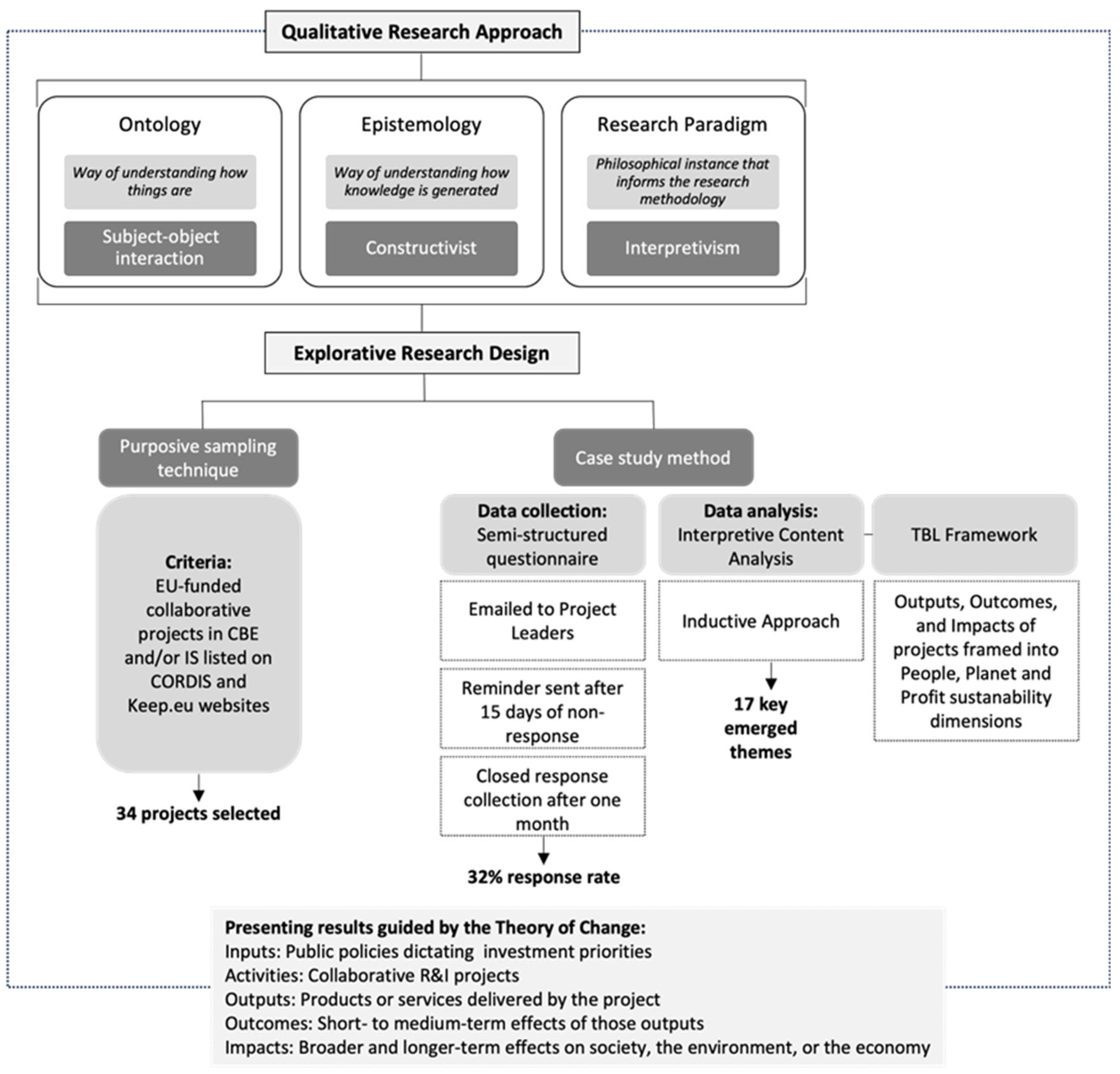
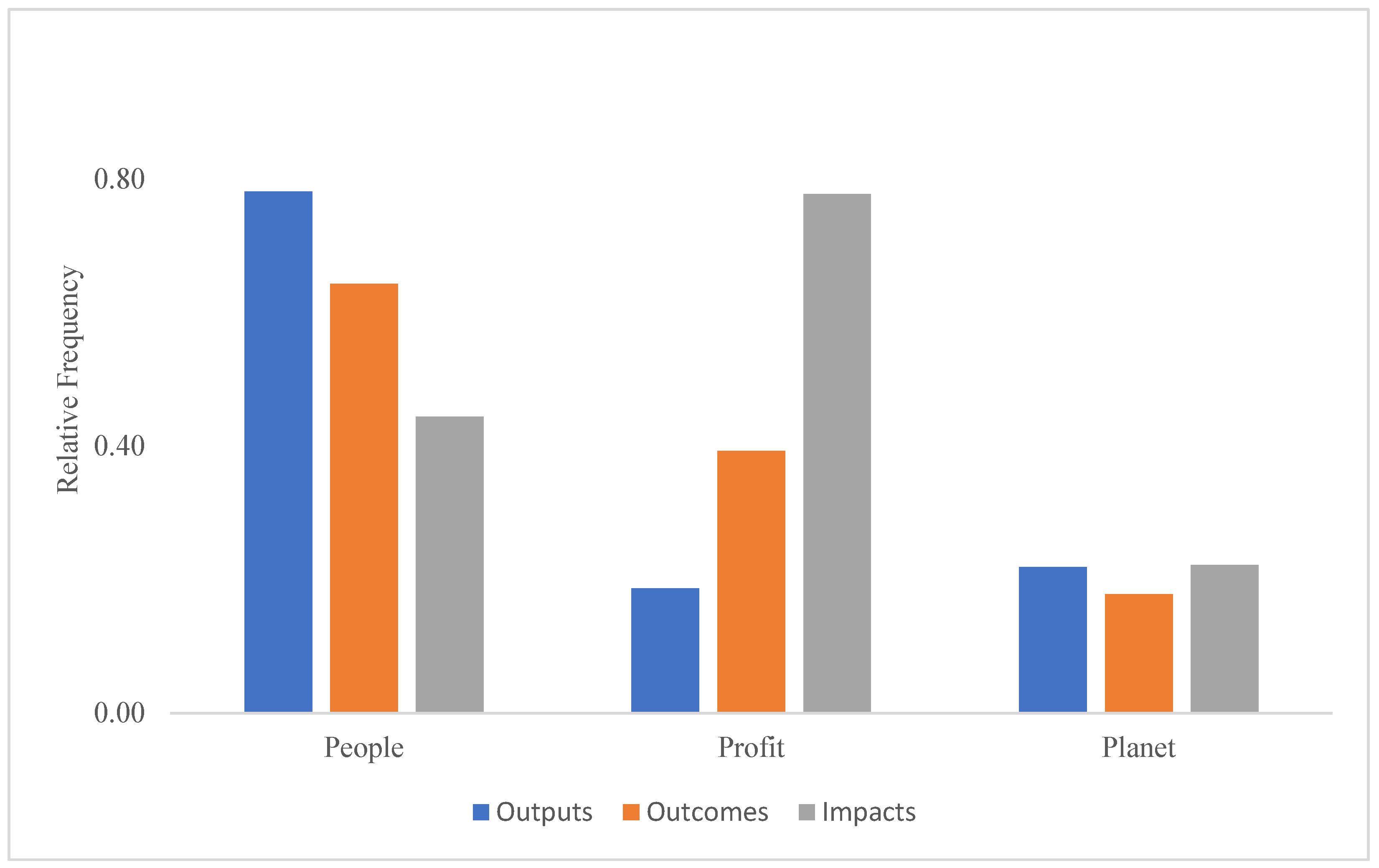
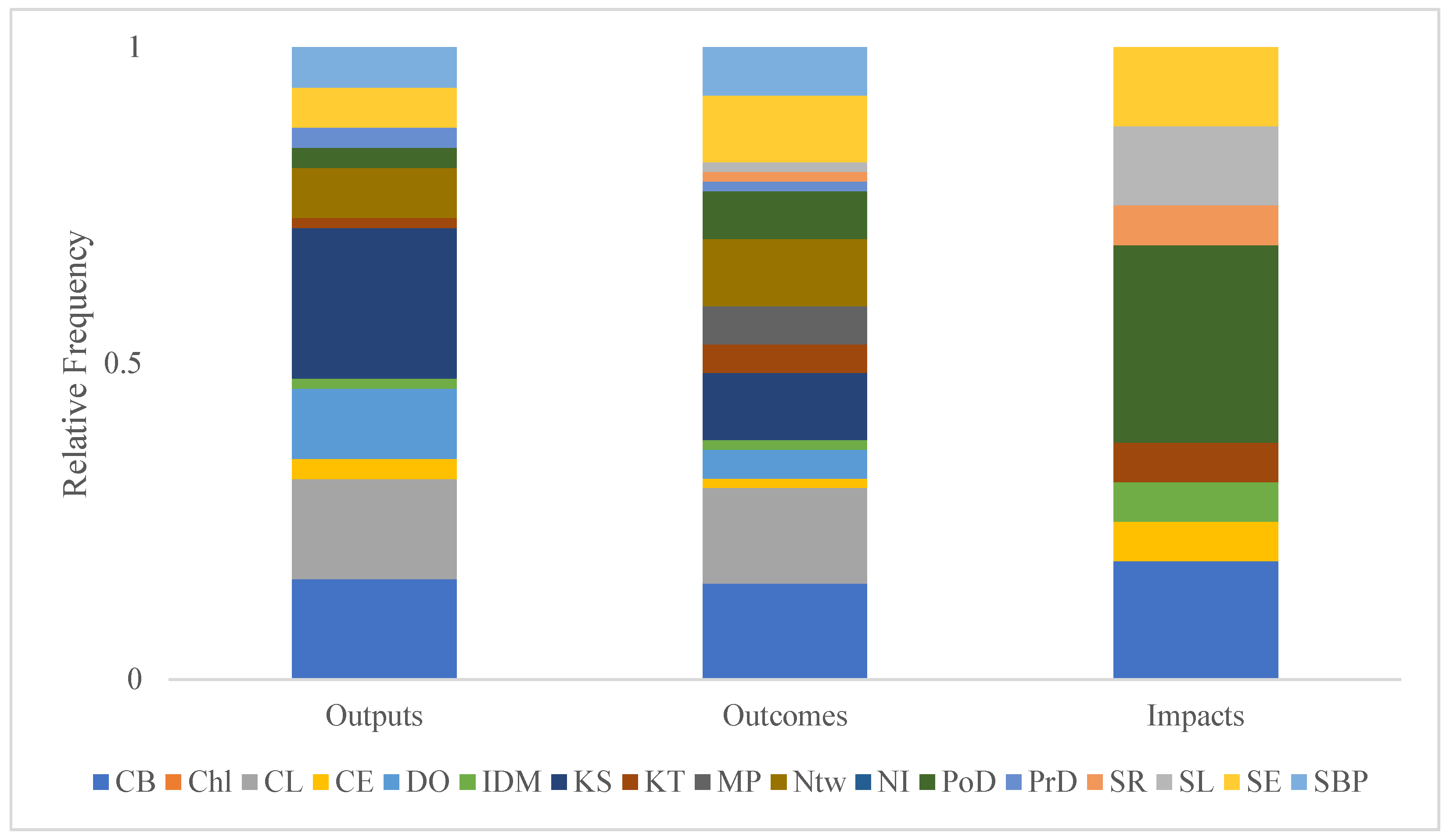
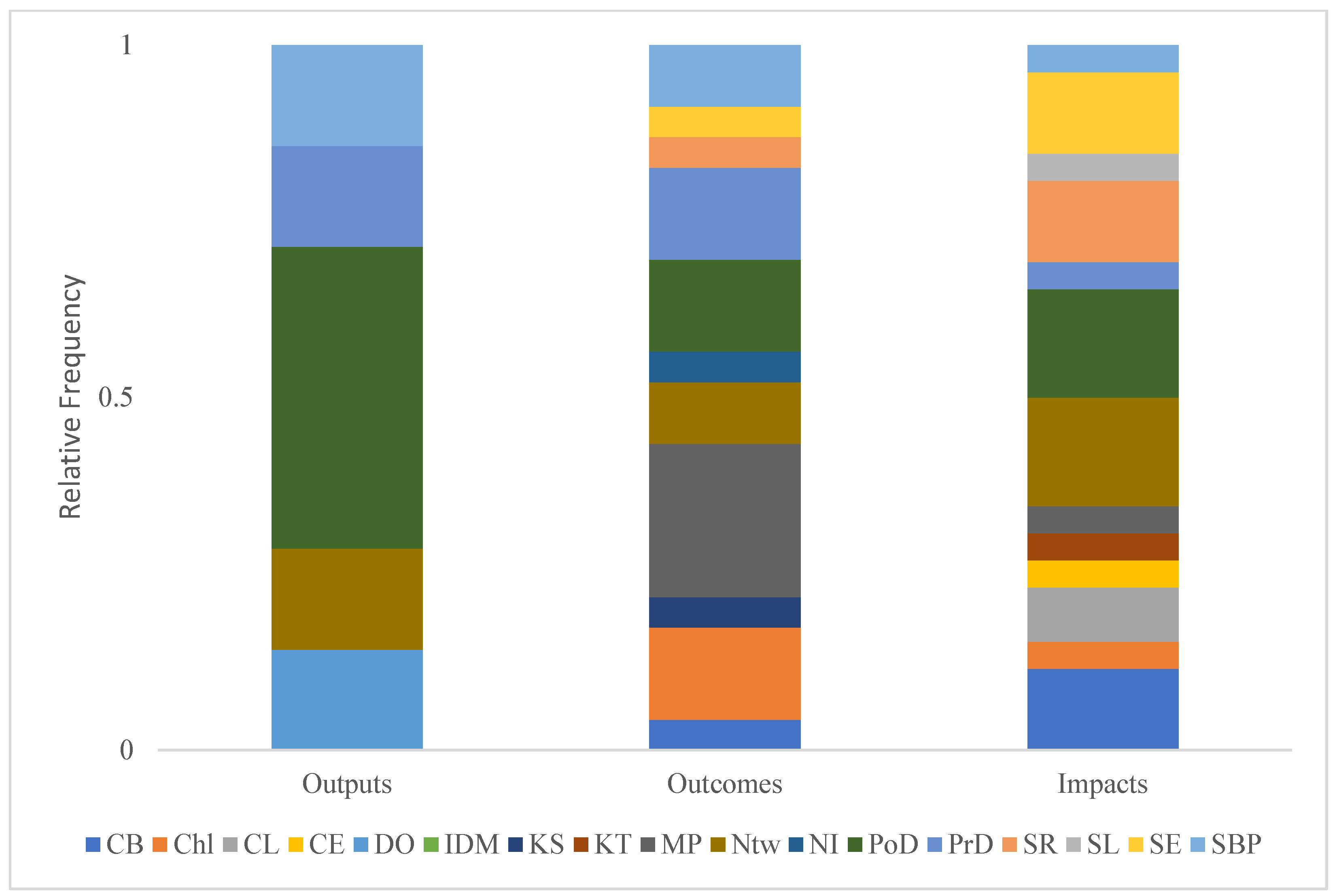
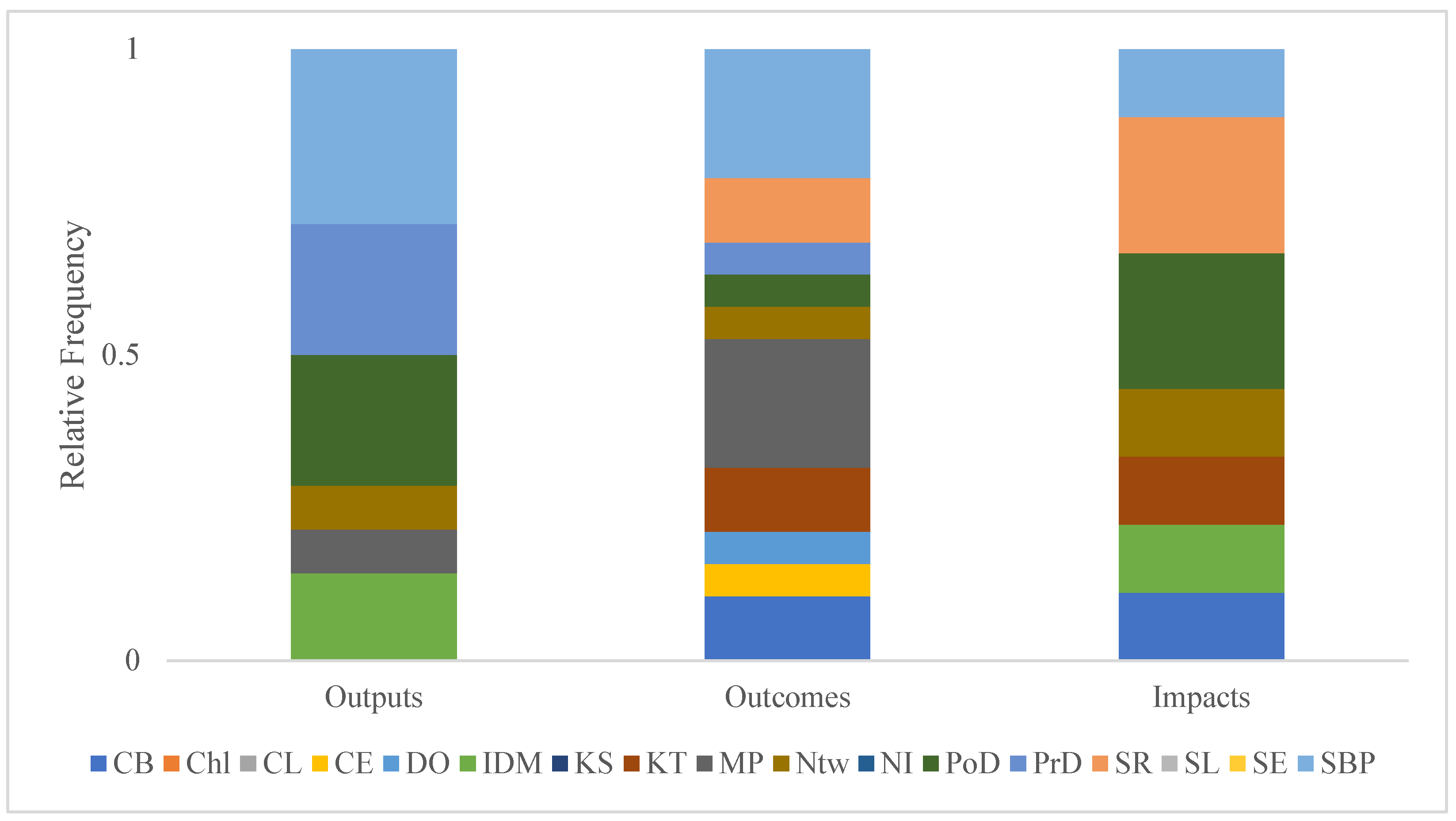
| Project Acronym | Implementation Period | Core Objective | Funder Programme | Funding Scheme | IP |
|---|---|---|---|---|---|
| INNOREX | 01/12/2012–31/05/2016 | To develop a novel reactor concept using alternative energies for the continuous, highly precise, metal-free polymerization of Polylactic Acid. | FP7-NMP | CP-FP | n.a. |
| SYNPOL | 01/10/2012–30/09/2016 | To revolutionize biopolymer production, integrating modern processing, syngas fermentation, and biowaste pyrolysis to address waste management challenges and position the EU as a global leader in sustainable biopolymer production. | FP7-KBBE | CP-TP | n.a. |
| SPLASH | 01/09/2012–28/02/2017 | To establish a sustainable bio-based industry using microalgae, with a focus on developing industrial biotechnology for producing polyesters and polyolefins, for applications in food packaging and fibers. | FP7-KBBE | CP-TP | n.a. |
| BIOREFINE-2G | 01/10/2013–30/09/2017 | To economically convert pentose-rich side-streams from 2nd generation biorefineries into dicarboxylic acids to produce bio-based polymers, emphasizing sustainability and profitability across the value chain. | FP7-KBBE | CP-TP | n.a. |
| STAR-ProBio | 01/05/2017–30/04/2020 | To drive the sustainability transition to a bio-based economy by developing a fit-for-purpose sustainability scheme, including standards and certifications, through integrated life-cycle assessments and case studies for bio-based products. | H2020-EU.3.2.4.3. | RIA | n.a. |
| DIET | 01/05/2018–30/04/2020 | To improve anaerobic digestion efficiency by introducing conductive materials, enhancing direct interspecies and electron transfer. | H2020-EU.1.3.2. | MSCA-IF-EF-ST | n.a. |
| CIRCTER | 10/10/2017–27/09/2019 | To focus on unveiling territorial dimensions of transitioning towards a CE, revealing local and regional material patterns and their alignment with CE. | 2014–2020 ESPON 2020 | n.a. | (11 ETC) |
| TRIS | 01/04/2016–31/03/2021 | To facilitate systemic IS integration across five European regions by enhancing SME competitiveness through IS practices. | 2014–2020 Interreg Europe | n.a. | (06g) |
| COASTAL Biogas | 01/07/2018–30/06/2021 | To address coastal eutrophication and advancing CBE through innovative anaerobic digestion solutions using cast seaweed. | 2014–2020 INTERREG VA South Baltic | n.a. | (06f) |
| ARDIA-Net | 01/10/2019–30/06/2022 | To foster value chains and leverage CBE and health economy trends by establishing an Alpine Research Development Area. | 2014–2020 INTERREG VB Alpine Space | n.a. | (11 ETC) |
| BIS | 01/01/2019–30/06/2021 | To promote IS and eco-innovation through strategic inter-industry collaborations in the Baltic region. | 2014–2020 INTERREG VB Baltic Sea | n.a. | (01b) |
| Code | Acronymn | Designation | Definition |
|---|---|---|---|
| 1 | CB | Capacity Building | Encompasses activities and initiatives aimed at enhancing the capabilities of individuals or organizations in the area of CBE and IS. It can include training programs, workshops, mentoring, and access to tools or technologies. e.g., “Training and peer-to-peer exchanges were held to build capacity among industrial symbiosis practitioners” |
| 2 | Chl | Challenges | Showcases obstacles and limitations in the project. It can cover economic, technical, and viability constraints. e.g., “Since [the project] is still at a low level of technological readiness with economic viability constraints” |
| 3 | CL | Collaborative Learning | Refers to the process of individuals or groups coming together (e.g., academia and practitioners) to actively engage in shared learning experiences, allowing them to learn from each other’s perspectives. The goal is to enhance collective understanding and improve the overall knowledge base of a group or organization. e.g., “Living Labs provided innovative arenas for both start-ups, SMEs and large companies to analyze, test and discuss their resource flows and the development of new products” |
| 4 | CE | Community Empowerment | Refers to the collective effort to empower local communities by fostering active participation, education, and support in local activities related to sustainable practices. e.g., “Establishment of local stakeholder groups to share project outputs and develop local activity” |
| 5 | DO | Dissemination and Outreach | Refers to actively spreading knowledge and information to a wider audience (such as the public, other organizations, policymakers, or specific target groups) beyond the immediate organization or community. It aims to promote awareness, education and engagement. e.g., “Roadshow events were arranged (…) to disseminate all the learnings, articles, policy reports, guidelines and tools created” |
| 6 | IDM | Informed Decision Making | Focuses on providing guidance, assistance, and access to information to enable individuals or organizations to make informed decisions to drive sustainable practices. e.g., “Decision support tool and training kit” |
| 7 | KS | Knowledge Sharing | Refers to the process of distributing knowledge among individuals or groups within an organization or community. It involves making knowledge accessible through various channels, such as conversations, meetings, presentations, workshops, documentation, and digital platforms. e.g., “Build a shared base of Good Practices for subsequent learning” |
| 8 | KT | Knowledge Transfer | Refers to a specific process aimed at transferring knowledge from one party to another. The emphasis is on the practical applicability of the knowledge that is acquired and transferred, aiming to facilitate the replication or utilization of this knowledge among the project partners, or in other projects or organizations. e.g., “Cross-border technology guidance and transfer in cast seaweed co-digestion” |
| 9 | MP | Market Potential | Refers to the recognition of commercial value associated with a product or service. It also reflects the intention to enhance product/service attributes, performance, or market competitiveness, focusing on identifying and implementing methods that are both efficient and economically viable. e.g., “In addition to [biogas company] that is ready to implement the results of the project, other biogas operators were informed, among others (…)” |
| 10 | Ntw | Networking | Highlights the social dimension of sustainability, recognizing the importance of building relationships and fostering collaboration to promote effective sustainable initiatives. e.g., “Screening of resources and matchmaking attracted companies eager to find sustainable green business models” |
| 11 | NI | New Initiatives | Includes cases where the project has led to the development of new initiatives, projects, or endeavours in the field of R&I. It specifically emphasizes the creation of new efforts driven by the activities of the original project. e.g., “The development of other European projects” |
| 12 | PoD | Policy Development | Represents all activities related to policies formulation, implementation, and evaluation within the context of CBE and IS. e.g., “The improvement of the regional policies addressing: Production and management of industrial waste; Efficient production processes; Access to innovative technologies and production techniques; Launch of new business strands and penetration of new markets” |
| 13 | PrD | Product Development | Represents the process of creating, improving, or optimizing a product, service, or new technological solutions and processes that contribute to the circularity and efficiency of bio-based systems and IS initiatives. e.g., “5 improved methods related to collection, pre-treatment and anaerobic digestion of seaweed” |
| 14 | SR | Sector Resilience | Focuses on increasing the resilience of sectors involved in the CBE and IS to various challenges and disruptions. e.g., “The improved concept including improved methods for collection, pre-treatment and anaerobic digestion of cast seaweed was discussed continuously with [biogas company] and is expected to be implemented in the Municipality”. |
| 15 | SL | Skilled Labour | Represents the creation of job opportunities for highly qualified individuals within the industry, resulting from the transition of researchers from academia to the industrial sector. e.g., “Creation of opportunities (direct or indirect) for scientific employment in industry” |
| 16 | SE | Stakeholder Engagement | Refers to the active involvement and collaboration of diverse stakeholders, including local community, policymakers, and decision-makers to promote the CBE and IS. e.g., “Council meetings acted as a platform for dialogue and policy learning” |
| 17 | SBP | Sustainable Business Practices | Focuses on developing and promoting business models that align with sustainability principles. It includes, green business models, waste valorization, resource optimization, and environmental protection. e.g., “(…) a best-practice example of how a community is already benefiting from using seaweed as a substrate to produce biogas and organic fertilizer, and at the same time benefits from a large number of additional socio-economic benefits” |
| Investment Priority/Funding Scheme | Emerging Themes |
|---|---|
| (01b) Promoting business investment in R&I | Capacity building, community empowerment, networking, skilled labor |
| (06f) Promoting innovative technologies | Knowledge sharing, knowledge transfer, product development |
| (06g) Supporting industrial transition | Informed decision making, sector resilience, stakeholder engagement |
| (11 ETC) Enhancing institutional capacity | Capacity building, collaborative learning, dissemination and outreach, policy development |
| FP7-NMP—“Cooperation”: Nanosciences, Nanotechnologies, Materials and new Production Technologies | Capacity building, collaborative learning, knowledge transfer, networking, product development, market potential |
| FP7-KBBE—“Cooperation”: Food, Agriculture and Biotechnology | Collaborative learning, networking |
| H2020-EU.3.2.4.3.—Supporting market development for bio-based products and processes | Capacity building, collaborative learning, market potential, networking |
| H2020-EU.1.3.2.—Nurturing excellence by means of cross-border and cross-sector mobility | Community empowerment, sissemination and outreach, sustainable business practices |
| CP-FP—Collaborative Projects: Small or medium-scale focused research projects | Capacity building, collaborative learning, knowledge sharing, networking, product development |
| CP-TP—Collaborative Project targeted to a special group (such as SMEs) | Collaborative learning, knowledge sharing, networking, skilled labor |
| RIA—Research and Innovation Actions | Capacity building, collaborative learning, knowledge sharing, networking, product development |
| MSCA-IF-EF-ST—Marie Sokolowski-Curie actions Standard European Fellowships | Dissemination and outreach, skilled labor |
Disclaimer/Publisher’s Note: The statements, opinions and data contained in all publications are solely those of the individual author(s) and contributor(s) and not of MDPI and/or the editor(s). MDPI and/or the editor(s) disclaim responsibility for any injury to people or property resulting from any ideas, methods, instructions or products referred to in the content. |
© 2024 by the authors. Licensee MDPI, Basel, Switzerland. This article is an open access article distributed under the terms and conditions of the Creative Commons Attribution (CC BY) license (https://creativecommons.org/licenses/by/4.0/).
Share and Cite
Brandão, A.S.; Santos, J.M.R.C.A. Sustainability from Policy to Practice: Assessing the Impact of European Research and Innovation Frameworks on Circular Bioeconomy. Sustainability 2024, 16, 2355. https://doi.org/10.3390/su16062355
Brandão AS, Santos JMRCA. Sustainability from Policy to Practice: Assessing the Impact of European Research and Innovation Frameworks on Circular Bioeconomy. Sustainability. 2024; 16(6):2355. https://doi.org/10.3390/su16062355
Chicago/Turabian StyleBrandão, Ana Sofia, and José M. R. C. A. Santos. 2024. "Sustainability from Policy to Practice: Assessing the Impact of European Research and Innovation Frameworks on Circular Bioeconomy" Sustainability 16, no. 6: 2355. https://doi.org/10.3390/su16062355
APA StyleBrandão, A. S., & Santos, J. M. R. C. A. (2024). Sustainability from Policy to Practice: Assessing the Impact of European Research and Innovation Frameworks on Circular Bioeconomy. Sustainability, 16(6), 2355. https://doi.org/10.3390/su16062355






